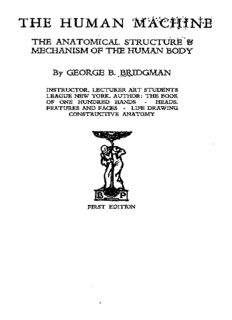
The human machine; the anatomical structure & mechanism of the human body. PDF
Preview The human machine; the anatomical structure & mechanism of the human body.
HUMAN THE MAX:.. THE ANATOMICAL STRUCTURE" MECHANISM OF THE HUMAN BODY GEORGE By B. .BREDGMAN INSTRUCTOR, LECTURER ART STUDENTS LEAGUE NEW YORK, AUTHOR: THE BOOK OF ONE HUNDRED HANDS - HEADS, FEATURES AND FACES - LIFE DRAWING CONSTRUCTIVE ANATOMY FIRST EDITION COPYRIGHT JANUARY, 1939 GEORGE BRIDGMAN By B, PELHAM, N. Y. PUBLISHED JANUARY. 1939 - ALL RIGHTS RESERVED INTRODUCTION IT appears to be a fixed law that the contraction of a muscle shall be toward its centre, therefore, the subject for mechanism on each occasion is so to modify the figure, and adjust the position of the muscle as to produce the motion required agreeably with this law. This can only be done by giving to different muscles a diversity of configuration suited to their several offices and to their situation with respect to the work which they have to perform. On which account we find them under a multiplicity of forms and altitudes; sometimes with double, sometimes with treble tendons; sometimes with none, sometimes with one tendon to several muscles; at other times with one muscle to several tendons. The shape of the organ is susceptible of an incalculable variety, while the original property of the muscle. The law and line of its contraction remains the same and is simple. Herein the muscular system may be said to bear a perfect resemblance to our works of art. An artist does not alter the native quality of his materials or their laws of action. He takes these as he finds them. His skill and ingenuity are employed in turning them such as they are, to his account by giving to the parts of his machine a form and relation in which these unalterable properties may operate , . t' < ' to the production of the effects intended; Pallet's Theology. Dedicated To Louise TABLE OF CONTENTS The Temporal Muscle 10 Superficial Muscles of the The Neck 15 Back 78 Mechanism of the Neck .... Scapular Region 83 Construction of the Hand Mechanism of the Scapular . . Region 84 Forearm Front View .... 25 The Pelvis Bone Forearm Back View 27' , +The Pelvic Region Side Pronator and Supinator . . . 30/ View 91 Forearm 33 Muscles of the Hip 93 The Arm Front View 35 Hip and Thigh 94 . . . The Arm Back View .... 37xThe Pelvic Region Back View 97 The Arm Outer View 39 . . . The Arm Inner View .... 41 Lubricating System 101 Arm and Forearm 42 The Thigh Front View . . 103 Muscles of the Thigh 104 and 44 Biceps Triceps Arm Inner View 46 Thigh and Leg 106 Hip and Thigh 108 Mechanism of the Arm .... 48 Mechanism of the Thigh ... 110 Arm and Forearm The Thigh Back View ... 113 Outer View 50 The Knee 116 The Mechanism of the Elbow Side and Back View 52 The Knee Front View .119 . . Elbow Front View 54 The Knee Back View . .121 The Skeleton 57 The Knee Outer View .123 The Trunk Front View 59 The Knee Inner View . .125 . . The Planes of the Trunk- Ajechanism of the Knee .126 Front View 60 fv wF^ront V>fi+ew 127 (Leg Muscles 63 Leg Back View 131 Deltoid and Pectoral 64 Leg Outer View 133 Shoulder Girdle 66 LegOuter Vfew 135 \ Trunk Side View 67 TKnee and Leg 137 Rib Cage and Trunk Bones and Muscles of the Side View 70 Foot ...138 : Trunk Back View :..:.,. 73 Turning of the Foot 141 . . The Trunk and Hips, 74 The Foot;and the Toe$ - .' . .143 ; SKULLS 1- FRONTAL IN FRONT 2-OCCEPITAL BACK OF HEAD 3-TEMPORAL TEMPUS TIME TEMPLE 4- MALAR CHEEK SOME '""* 7V/ / 5* INFERIOR y LOWER MAX LLARY ft^f^/^ JAW I GL ., BONE: FACIAL MUSCLES THE FACfAi- HAVE A FIXED ROlHT MUSCLES TO THE BONE, TH THE BONES OF THE THE HEAD ARE IMMOVABLE IS MUSCLES- OF MASTICATION MOVE. THE LOWER JAW PLANES THE MASSES REPRESENTED OF THE HEAD BY PUNKS WHEN THE HEAD TH TURNED OK PUNESARE IS HOWEVER THE. MASSES OFTHH TURNED HEAD P.EMA1MTHE5AMS PiAM5 ARE mONT AND TOIP stots LIGHT AND SHADE HAVE A OF A CONCEPTION SOLID BODY A DECIDED BETWEEN THE : DIFFERENCE LIGHTAND SHAD OF EQUAL SIZE NO NEAR TONES OR INTENSITY i r I '" ( THE TEMPORAL MUSCLE The mouth was made to cut and grind food. To save this trouble and work, mechanical devices such as the mill- stone were put into operation. Here the upper stone ground while the lower was stationary. In the human machine, the upper stone is fixed and the lower does the grinding. The only movable bone of the skull is the lower jaw which hinges to the head just in front of the ear. It acts as a lever of the third order. The cutting and grinding force is controlled by powerful muscles. The one that raises the lower jaw is named l..The temporal muscle; attached to the coronoid portion of lower jaw it passes upward under the zygomatic arch covering the temporal fossa. From its attachment above, its fibres converge before passing under the arch. 2 Inferior maxillary lower jaw. . . 3 Zygomatic arch. . . [10]
Description: